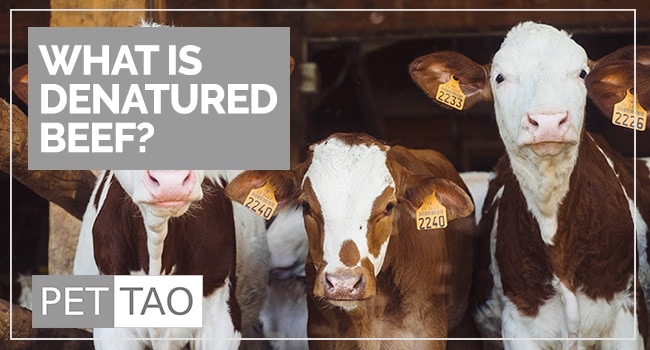In fact, “with” only means “the named ingredient must constitute at least 3% of the product weight exclusive of water.”
You’re a concerned pet parent. You read blogs and magazine articles about pet food trends.
You recently heard some controversy about denatured meat.
Many companies use denatured meat, usually beef, in pet foods.
But, PET | TAO products DO NOT contain denatured meat.
So, what is denatured meat? And why is it in most pet foods?
First, a science lesson
In raw meat, individual protein molecules are wound up in coils. Bonds hold these coils together. As the meat heats up, bonds break unwinding the protein molecules.
The heating process also shrinks the muscle fibers as water evaporates, shortening the fiber in length and diameter. The protein molecules then coagulate.
The process – breaking, unwinding, and coagulating – which changes the structure of the protein, is denaturing.
There are other ways to denature meat. For example, charcoal is a common denaturing agent.
A product called LIQICHAR is an FDA-approved product many manufacturers add to pet food. The charcoal-colored liquid dilutes with water at a rate of 50 to 1.
Why is Denatured Meat Controversial?
Consumers have many reasons to question denatured meat.
First of all, denatured meat comes from animals “not intended for human consumption.” Meat receives this designation for many reasons, including, but not limited to: meat from animals that are dying, diseased, or disabled.
According to the USDA, “Unless it is identified as required by regulations to deter its use as human food, no carcass, or part or product of a carcass, capable of use as human food that is adulterated or misbranded can be offered for transportation in commerce unless it is denatured.”
Second, charcoal has become the preferred denaturing solution for pet food manufacturers because it is “all-natural.”
However, identifying agents used as denaturants in USDA inspected facilities include:
- Crude carbolic acid;
- Cresylic disinfectant;
- FD&C No. 3 green;
- FD&C No. 1 blue;
- FD&C No. 2 blue;
- FD&C No. 3 green, water, liquid detergent, and oil of citronella;
- Kerosene, fuel oil, or used crankcase oil;
- ‘Other proprietary substance’ approved by the USDA;
- Powdered charcoal or black dyes.
“Other proprietary substance’ approved by the USDA” is the one that makes many pet owners suspicious.
Since the USDA allows chemical manufacturers the freedom to use ‘other proprietary denaturants,’ many companies create their own products, thus they are proprietary and a “trade secret.”
According to the FDA, “The basic purpose of denaturing is to prevent salvage or diversion of violative materials for human consumption.”
Are your meats denatured?
Here’s a good question to ask your manufacturer.
If your meats aren’t denatured, what does your company do to assure the USDA will not use a denaturing agent?
If your meats are denatured, what denaturing product(s) do you use?
PET | TAO’s Answer: Our meats are not denatured because human-edible ingredients do not need to be denuatured.
Nutripack, our manufactNurer, only uses human-grade meat in our formulas. Denaturing agents aren’t necessary.
PET | TAO customers are concerned with pet parents. Our current and future customers pride themselves on being informed consumers.
We understand ingredient selection and recipe choices are important factors in choosing your pet’s diet.








